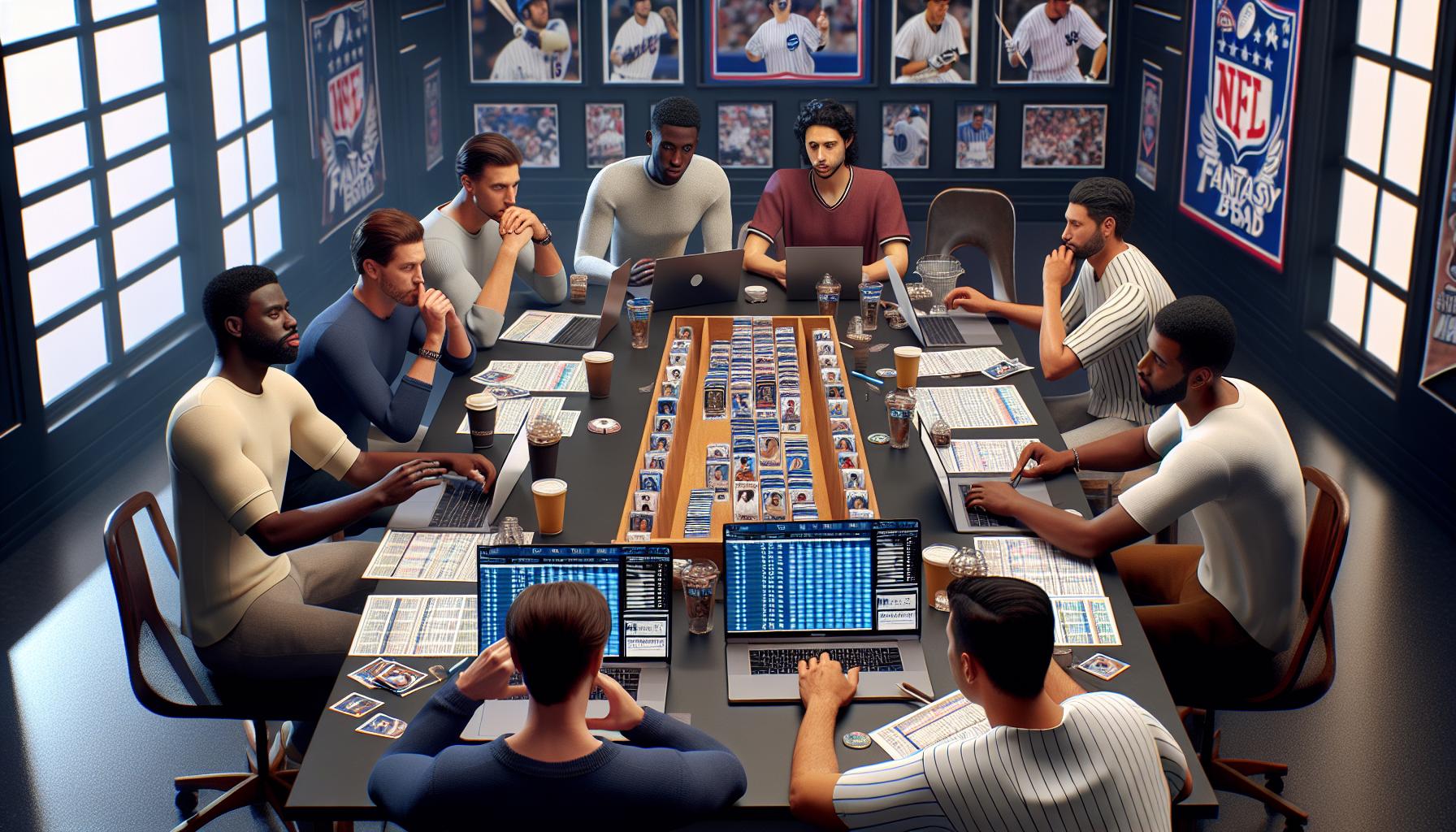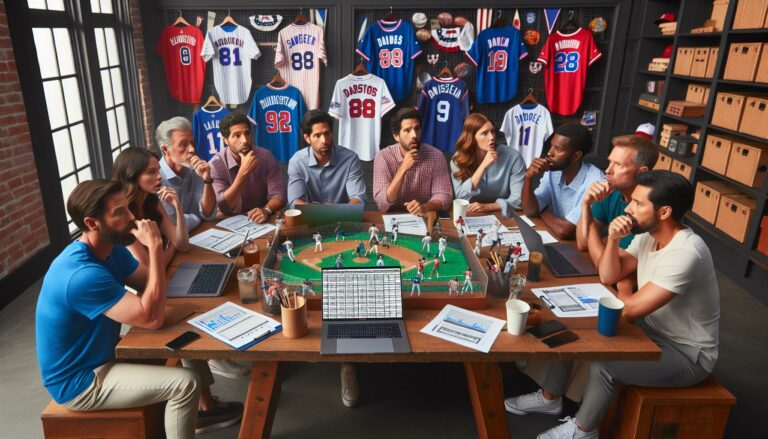Fantasy baseball auction drafts transform everyday fans into high-stakes traders juggling budgets and battling for baseball’s biggest stars. While traditional snake drafts follow a predictable pattern auction drafts inject the thrill of dynamic bidding and strategic spending into every pick.
Getting auction values right can make the difference between dominating your league and watching your fantasy season crash before Opening Day. Savvy managers know it’s not just about spending big on superstars – it’s about finding the perfect balance between elite talent and hidden gems that’ll deliver maximum return on investment. Whether you’re a seasoned auction veteran or diving into the format for the first time this season understanding player values is crucial for draft day success.
Understanding Fantasy Baseball Auction Values
Fantasy baseball auction values represent the estimated worth of players in a draft format where managers bid virtual dollars from a fixed budget to acquire talent. These values serve as crucial benchmarks for making informed bidding decisions during auctions.
Budget Management Strategies
Effective budget allocation starts with dividing the total auction budget between hitting and pitching assets. A standard 70-30 split favors hitting positions due to their everyday playing time reliability. Successful managers reserve 15-20% of their budget for endgame acquisitions to capitalize on bargains late in the draft. Position scarcity influences budget allocation, with premium positions like shortstop commanding higher portions. Setting maximum bid limits for each roster spot prevents overspending on early nominations while maintaining flexibility for targeted players.
| Category Specialist Type | Typical Value Range |
|---|---|
| Power Hitters | $28-40 |
| Speed Specialists | $20-32 |
| Ace Pitchers | $25-35 |
| Closers | $12-22 |
Player Valuation Methods

Player valuation in fantasy baseball auctions combines statistical analysis with market dynamics to determine optimal bidding prices. These methods create a foundation for strategic budget allocation during draft day.
Statistical Analysis
Statistical analysis transforms raw player performance data into actionable auction values. Projections systems evaluate key metrics including batting average, home runs, RBIs, stolen bases for hitters plus wins, strikeouts, ERA, WHIP for pitchers. Advanced metrics like wOBA, xFIP, BABIP provide additional context for player evaluation. The Z-score method quantifies a player’s contribution above replacement level in each category.
| Key Metrics | Hitting | Pitching |
|---|---|---|
| Primary Stats | AVG, HR, RBI, SB | W, K, ERA, WHIP |
| Advanced Stats | wOBA, BABIP | xFIP, K/9 |
| Value Above Replacement | 5-15% premium | 3-8% premium |
| Position | Scarcity Premium |
|---|---|
| Shortstop | 15-20% |
| Catcher | 10-15% |
| Second Base | 8-12% |
| Third Base | 5-8% |
| Outfield | 0-3% |
Top Players Worth The Investment
Strategic investment in high-value players forms the foundation of a competitive fantasy baseball team. Proper allocation of auction dollars maximizes roster potential while maintaining budget flexibility.
Elite Tier Values
Premium players like Juan Soto, Ronald Acuña Jr. and Mookie Betts command 35-45% of auction budgets. Elite hitters provide consistent production across multiple categories, justifying their elevated price tags. Ronald Acuña Jr. delivers rare power-speed combinations, contributing significantly in home runs (40+) stolen bases (50+) runs (100+). Mike Trout maintains top-tier value through exceptional batting average (.280+) while providing reliable power numbers. Pitching aces like Gerrit Cole Spencer Strider offer stability through high strikeout totals (200+) quality ratios (sub-3.00 ERA) innings volume (180+).
Mid-Range Bargains
Several established players offer substantial value in the $15-25 range. Christian Walker produces similar power numbers (30+ HR 100+ RBI) to higher-priced alternatives at a fraction of the cost. Ketel Marte provides multi-position eligibility plus above-average production in batting average (.280+) runs (80+). Starting pitchers like Logan Webb Blake Snell deliver quality innings dependable ratios at moderate auction prices. Proven closers including Raisel Iglesias Josh Hader secure saves (30+) strikeouts (80+) while maintaining reasonable costs compared to elite relievers.
Common Auction Value Mistakes
Fantasy baseball auction drafts require precise player valuation to maximize team potential. Understanding common pitfalls helps managers avoid costly errors during the bidding process.
Overpaying For Names
Brand recognition drives up auction prices for well-known players beyond their statistical worth. Players like Fernando Tatis Jr. often command premiums of 20-25% above their projected value due to name recognition. Established veterans such as Max Scherzer fetch higher bids based on past performance rather than current projections. Recent examples include Francisco Lindor’s average auction price of $32 despite a projected value of $26 in standard formats. Focusing on statistical production instead of player reputation leads to more efficient budget allocation. Elite players from smaller market teams like Corbin Carroll provide similar production at 15-20% lower costs.
Ignoring League Settings
Custom league settings directly impact player values across different categories. A league with OBP instead of batting average increases the value of players like Juan Soto by 25-30%. Points leagues value starting pitchers 20% higher than traditional 5×5 formats. Position eligibility rules alter scarcity premiums, with multi-position players like Trea Turner commanding an additional 10-15% in leagues with strict roster requirements. Keeper league inflation rates affect current-year values by 30-40% for top prospects. League-specific scoring systems create unique value opportunities that standard rankings fail to capture.
Price Adjustment Factors
Fantasy baseball auction values require specific adjustments based on league parameters. These modifications ensure accurate player valuations across different league configurations.
League Size Impact
League size directly influences player auction values in fantasy baseball. In 10-team leagues, the player pool remains deeper, reducing the premium on top-tier talent by 10-15%. Twelve-team leagues represent the standard baseline for most auction values. Fourteen-team leagues increase elite player values by 15-20% due to position scarcity. Deep leagues with 15+ teams create additional value for reliable veterans with guaranteed playing time, boosting their prices by 25-30%. The number of roster spots per team also affects values, with each additional bench spot decreasing the available free agent pool by 8-12%.
Scoring Format Effects
Scoring categories create significant shifts in player values across different league formats. Traditional 5×5 rotisserie leagues establish baseline values for standard categories. Points leagues increase the value of starting pitchers by 20-25% due to innings volume bonuses. Head-to-head category leagues boost consistent performers’ values by 15-20%. OBP leagues enhance the value of high-walk players by 25-30%. Quality start leagues decrease win-dependent pitcher values by 10-15%. Additional hitting categories like doubles or total bases increase gap hitters’ values by 18-22%. Hold leagues create value for setup relievers, typically worth $3-5 in standard formats.
Draft Day Value Tactics
Maximizing value during an auction draft requires strategic player nominations and calculated late-round acquisitions. These tactical approaches create opportunities to secure players below their projected values while managing budget constraints effectively.
Nominating Strategy
Nominating expensive players early depletes competitors’ budgets while preserving flexibility for targeted mid-round acquisitions. Starting nominations with high-priced stars like Juan Soto ($45-50) or Ronald Acuña Jr. ($40-45) forces other managers to commit significant portions of their budget. Experienced managers nominate overvalued players they don’t want, such as injury-prone stars or rookies with inflated expectations. A smart tactic involves nominating secondary closers or popular sleeper picks when competitors have limited funds remaining. Timing nominations based on position runs helps avoid overpaying, particularly for scarce positions like shortstop or catcher.
End Game Bargain Hunting
The final phase of auctions presents opportunities to acquire valuable players at discounted prices. Managers with remaining budget leverage hold significant advantages during this stage, often securing $15-20 players for $5-8. Target consistent veterans like Brandon Nimmo or Charlie Morton who lack flashy upside but deliver reliable production. Capitalize on position flexibility by acquiring multi-eligible players to maximize roster utility. Focus on specialists who excel in specific categories: stolen base contributors, high-strikeout middle relievers, or batting average stabilizers. Monitor competing teams’ roster needs to identify players they can’t afford, creating opportunities for value acquisitions.
Conclusion
Success in fantasy baseball auctions demands a blend of preparation strategic thinking and adaptability. Armed with accurate player valuations and a solid understanding of market dynamics managers can build competitive rosters while avoiding common pitfalls.
The key lies in balancing star power with value picks while remaining flexible enough to capitalize on opportunities throughout the draft. Smart nomination strategies and careful budget management set the foundation for auction success.
Whether participating in a standard 5×5 rotisserie league or a custom format understanding how league parameters affect player values is crucial. By applying these principles and staying disciplined during the auction fantasy managers can maximize their chances of securing optimal value for every dollar spent.




